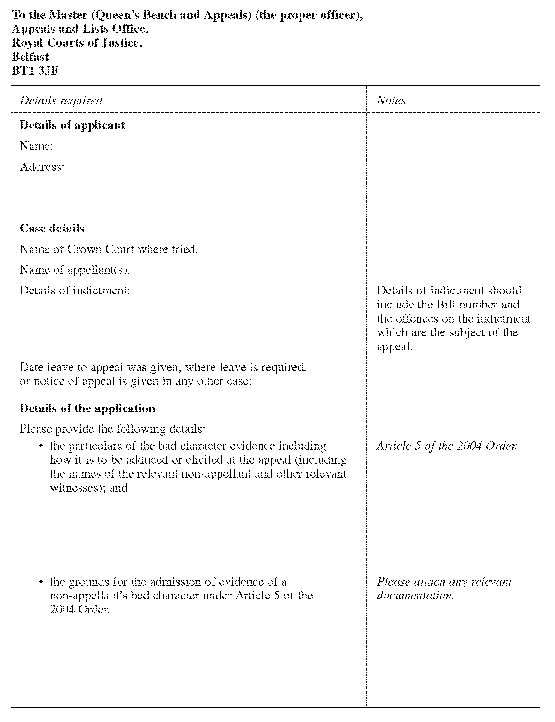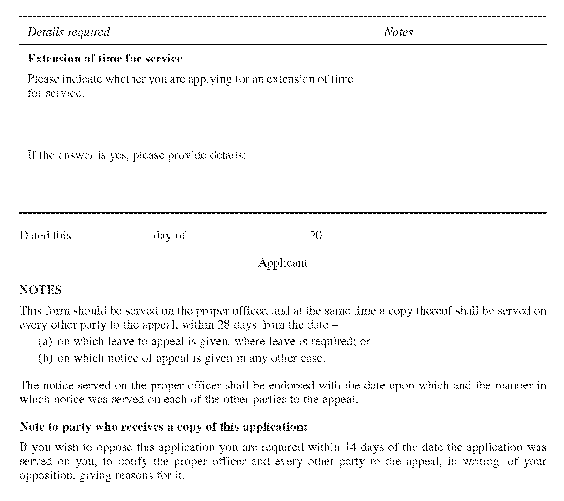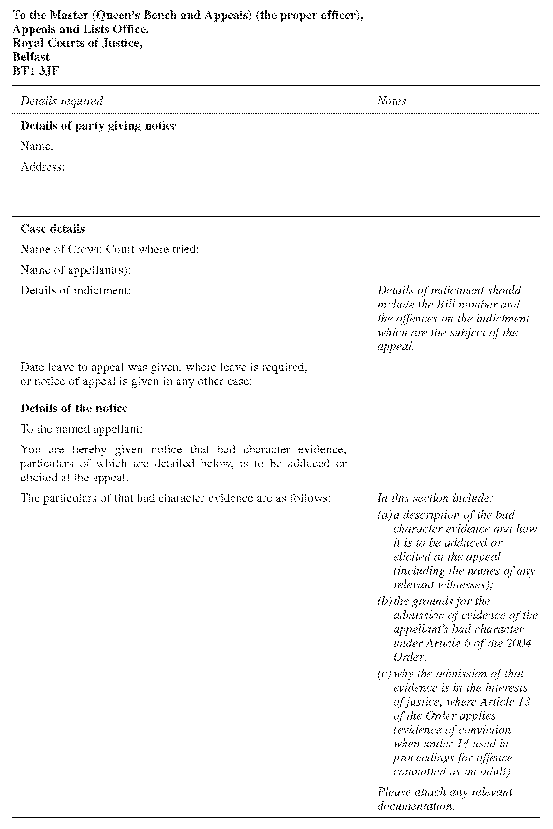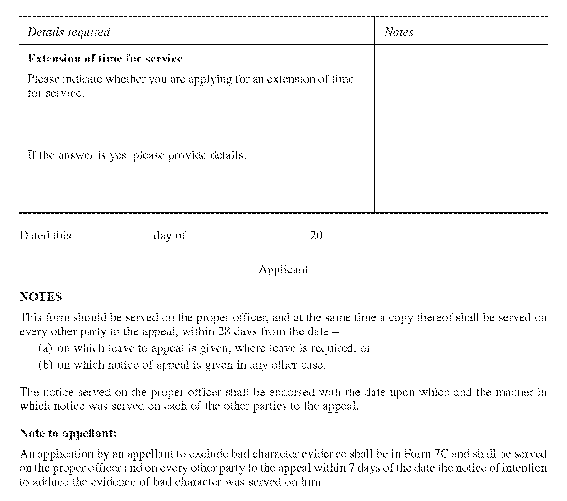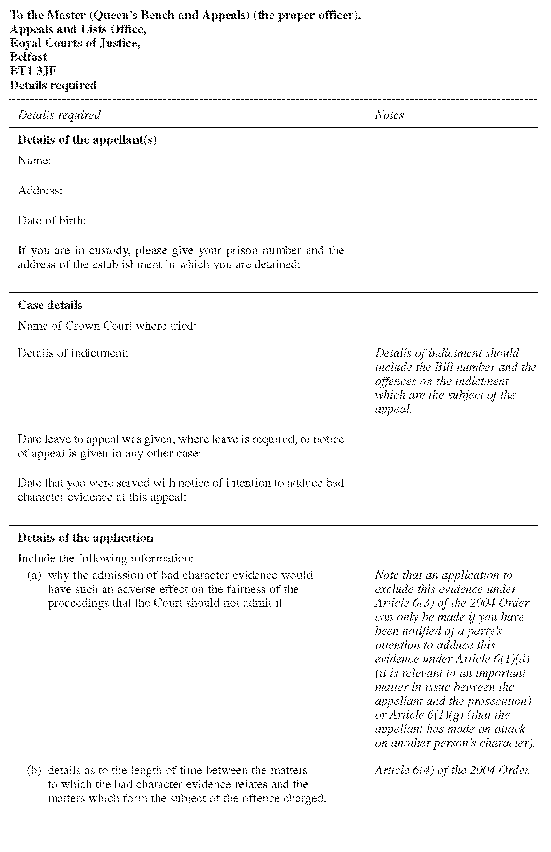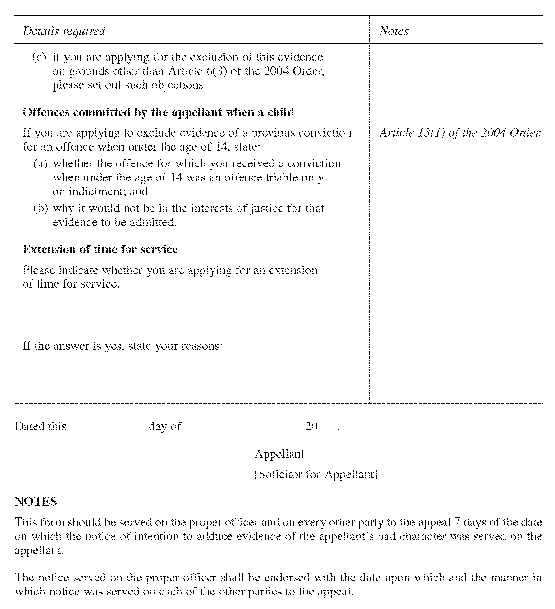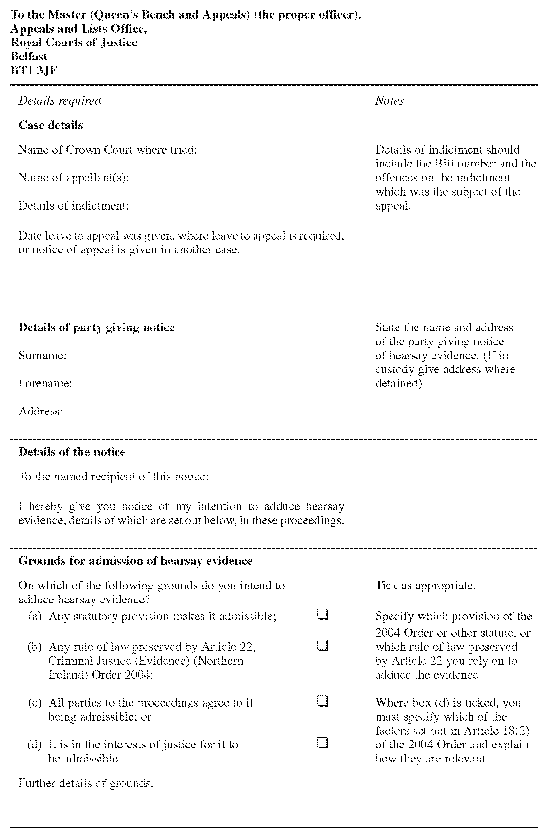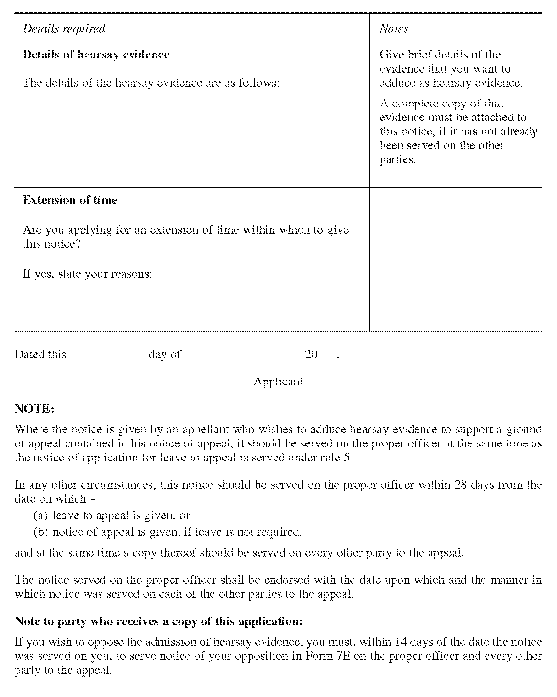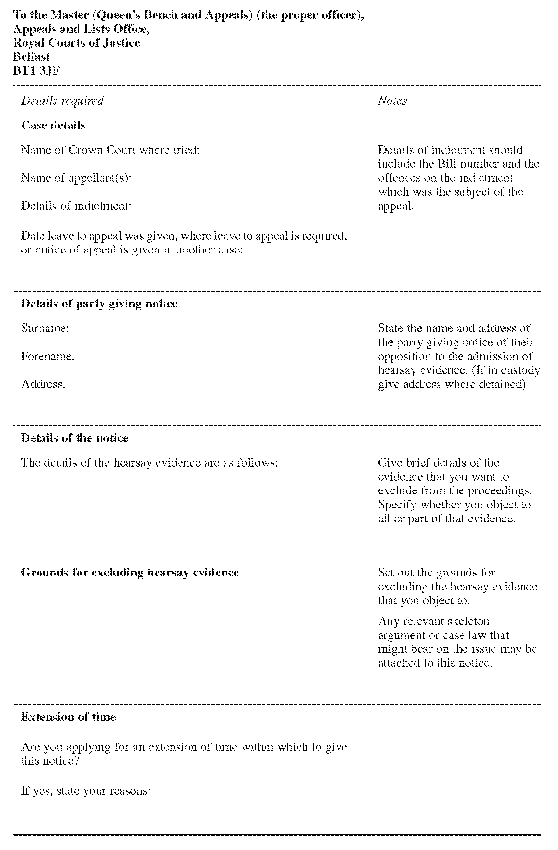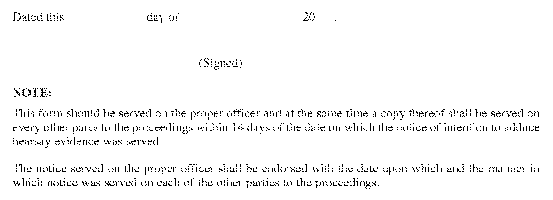- Latest available (Revised)
- Original (As made)
The Criminal Appeal (Amendment) (Northern Ireland) Rules 2005
You are here:
- Previous
- Next
More Resources
Status:
This is the original version (as it was originally made). This item of legislation is currently only available in its original format.
Statutory Rules of Northern Ireland
2005 No. 157
SUPREME COURT, NORTHERN IRELAND
The Criminal Appeal (Amendment) (Northern Ireland) Rules 2005
Made
21st March 2005
To be laid before Parliament
Coming into operation
18th April 2005
We, the Northern Ireland Supreme Court Rules Committee, being the authority having for the time being power under section 55 of the Judicature (Northern Ireland) Act 1978(1) to make, amend or revoke rules regulating the practice and procedure of the Supreme Court of Judicature of Northern Ireland, hereby with the concurrence of the Lord Chancellor, exercise those powers, the powers under Articles 16 and 35 of the Criminal Justice (Evidence) (Northern Ireland) Order 2004(2), and all other powers enabling us in that behalf as follows:
Citation, commencement and interpretation
1.—(1) These Rules may be cited as the Criminal Appeal (Amendment) (Northern Ireland) Rules 2005 and shall come into operation on 18th April 2005.
(2) In these Rules, “the principal Rules” shall mean the Criminal Appeal (Northern Ireland) Rules 1968(3), and a reference to a rule or a Form by number means the rule or Form so numbered in the principal Rules.
Amendment to the principal Rules
2.—(1) Rule 2(1) shall be amended by inserting after the definition of the “proper officer”, the following definition –
““the 2004 Order” means the Criminal Justice (Evidence) (Northern Ireland) Order 2004;”.
(2) Rule 7 shall be amended as follows –
(a)by inserting after paragraph (2), the following new paragraph –
“(2A) Form 7 need not be submitted in respect of any particular witness or evidence where the appellant has made an application under rule 7A or 7B in respect of that witness or evidence.”; and
(b)in paragraph (4), by deleting the words “or is under the sentence of death”.
(3) After rule 7, there shall be inserted the following new rules –
“Procedure for the admission of evidence of bad character
7A.—(1) A party who wants to adduce evidence of a non-appellant’s bad character or to cross examine a witness with a view to eliciting such evidence, under Article 5 of the 2004 Order, shall give notice which shall be in Form 7A.
(2) Notice under paragraph (1) shall be served on the proper officer and every other party to the appeal within 28 days from the date on which –
(a)leave to appeal is given, where leave is required; or
(b)notice of appeal is given, in any other case.
(3) Any party who wishes to oppose the application under paragraph (1) shall, within 14 days of the date that notice of the application was served on him, notify the proper officer and every other party to the appeal, in writing, of his opposition, giving reasons for it.
(4) A party who wants to adduce evidence of an appellant’s bad character or to cross examine a witness with a view to eliciting such evidence, under Article 6 of the 2004 Order, shall give notice which shall be in Form 7B.
(5) Notice under paragraph (4) shall be served on the proper officer and every other party to the appeal within 28 days from the date on which –
(a)leave to appeal is given, where leave is required; or
(b)notice of appeal is given, in any other case.
(6) An application by an appellant to exclude bad character evidence shall be in Form 7C and shall be served on the proper officer and on every other party to the appeal within 7 days from the date on which notice under paragraph (4) was served on him.
(7) An appellant who is entitled to have notice served on him under this rule may waive his entitlement by so informing the Court and the party who would have served the notice.
(8) The Court may, if it considers that it is in the interests of justice to do so, –
(a)allow a notice or application required under this rule to be given in a different form or orally; or
(b)abridge or extend the time for service of a notice or application required under this rule, either before or after that period expires.
Procedure for the admission of hearsay evidence
7B.—(1) This rule shall apply where a party wishes to adduce evidence on one or more of the grounds set out in Article 18(1)(a) to (d) of the 2004 Order and in this rule, such evidence is referred to as “hearsay evidence”.
(2) An appellant who wishes to adduce hearsay evidence to support a ground of appeal contained in his notice of appeal under rule 5(2)(a) shall give notice in Form 7D.
(3) Notice under paragraph (2) shall be served on the proper officer at the same time as the appellant serves the notice of appeal or notice of application for leave to appeal under rule 5(1).
(4) The proper officer shall send a copy of any notice served on him under paragraph (3) to the Director of Public Prosecutions at the same time as he sends to him a copy of the notice received under rule 5.
(5) A party who wishes to adduce hearsay evidence in any other circumstances shall serve notice in Form 7D on the proper officer and every other party to the appeal within 28 days from the date on which –
(a)leave to appeal is given, where leave is required; or
(b)notice of appeal is given, in any other case.
(6) Any party who wishes to oppose the admission of hearsay evidence under paragraph (2) or (5) shall, within 14 days of the date notice was served on him, notify the proper officer and every other party to the appeal, in Form 7E, of his opposition.
(7) A party who is entitled to have notice served on him under this rule may waive his entitlement by so informing the Court and the party who would have served the notice.
(8) The Court may, if it considers that it is in the interests of justice to do so, –
(a)dispense with the requirement to give notice of intention to adduce hearsay evidence;
(b)allow a notice required under this rule to be given in a different form, or orally; or
(c)abridge or extend the time for service of a notice required under this rule, either before or after that period expires.”
(4) Rule 24(2) shall be amended by deleting the words “or capital murder”.
(5) Rule 32(1) shall be amended by substituting for the words “shall either be made orally” to the end, the following –
“shall either be made –
(i)orally immediately after the decision of the Court from which an appeal lies to the House of Lords or, immediately after the giving of reasons by such Court if later; or
(ii)by serving Form 19 on the proper officer within 28 days of the decision of the Court or, of the giving of reasons by such Court if later.”.
(6) Rule 33 shall be revoked.
(7) The Schedule to the principal Rules shall be amended as follows –
(a)in Form 2, in Note 1, by deleting the words “except in the case of a conviction involving a sentence of death”;
(b)in Form 6,
(i)in Note 1(d), by deleting the words “including a sentence of death on the appellant”; and
(ii)in Note 4, by deleting the words “involving sentence of death or”;
(c)in Form 19, in Note 1,
(i)by substituting for the word “fourteen” the words “twenty eight”;
(ii)by inserting after the words “Court of Criminal Appeal” the words “or, if later, of the date of the giving of reasons by the Court.”.
(d)by inserting after Form 7, the new Forms 7A to 7E in the Schedule to these Rules.
Brian Kerr
J. M. Nicholson
Anthony Campbell
Paul Girvan
Patrick Coghlin
Mark Horner
Bernard McCloskey
Tony Caher
Caroline A. McGonagle
Dated 14th March 2005
Signed by authority of the Lord Chancellor
I concur,
Baroness Ashton of Upholland
Parliamentary Under-Secretary of State,
Department for Constitutional Affairs
Dated 21st March 2005
Rule 2(7)
SCHEDULEFORMS TO BE INSERTED IN THE CRIMINAL APPEAL (NORTHERN IRELAND) RULES 1968
Rule 7A(1)
FORM 7AAPPLICATION FOR LEAVE TO ADDUCE EVIDENCE OF NON-APPELLANT'S BAD CHARACTER(Article 5 of the Criminal Justice (Evidence) (Northern Ireland) Order 2004)
Rule 7A(4)
FORM 7BNOTICE OF INTENTION TO ADDUCE APPELLANT'S BAD CHARACTER EVIDENCE(Article 6 of the Criminal Justice (Evidence) (Northern Ireland) Order 2004)
Rule 7A(6)
FORM 7CAPPLICATION TO EXCLUDE EVIDENCE OF THE APPELLANT'S BAD CHARACTER(Articles 6 and 13 of the Criminal Justice (Evidence) (Northern Ireland) Order 2004)
Rule 7B(2) & (5)
FORM 7DNOTICE OF INTENTION TO ADDUCE HEARSAY EVIDENCE(Article 18 of the Criminal Justice (Evidence) (Northern Ireland) Order 2004)
Rule 7B(6)
FORM 7ENOTICE OF OPPOSITION TO THE ADMISSION OF HEARSAY EVIDENCE(Article 18 of the Criminal Justice (Evidence) (Northern Ireland) Order 2004)
Explanatory Note
(This note is not part of the Rules.)
These Rules amend the Criminal Appeal (Northern Ireland) Rules 1968 (“the principal Rules”) to –
prescribe the procedure relating to applications to adduce bad character evidence under Part II of the Criminal Justice (Evidence) (Northern Ireland) Order 2004;
prescribe the procedure relating to the giving of notice of intention to adduce hearsay evidence under Part III of that Order; and
take account of a number of amendments made to the Criminal Appeal (Northern Ireland) Act 1980 by the Courts Act 2003.
Rule 2(2)(a) amends rule 7 of the principal Rules to provide that an application for an order requiring a witness to attend for examination or for evidence to be received by the Court need not be submitted where the appellant has made an application under rule 7A or 7B in respect of that witness or evidence.
Rule 2(2)(b), (4) and (6) delete references in the principal Rules to “sentence of death” and “capital cases”.
Rule 2(3) inserts a new rule 7A, which prescribes the procedure to be followed on an application to –
adduce evidence of the bad character of persons other than the appellant or to cross examine a witness with a view to eliciting such evidence (new rules 7A(1) and (2));
oppose the admission of evidence the bad character of persons other than the appellant (new rule 7A(3));
adduce evidence of an appellant’s bad character or to cross examine a witness with a view to eliciting such evidence (new rules 7A(4) and (5));
exclude evidence of an appellant’s bad character (new rule 7A(6)).
New rule 7A(7) provides that the appellant may waive service of any application or notice. The Court may also allow a notice or application to be given in a different form or orally, and may abridge or extend any of the time limits (new rule 7A(8))
Rule 2(3) also inserts a new rule 7B, which prescribes the procedure to be followed on an application to –
adduce hearsay evidence (new rules 7B(1) to (5));
oppose the admission of hearsay evidence (new rule 7B(6)).
New rule 7B(7) provides that a party may waive his entitlement to be served with any notice under new rule 7B.
New rule 7B(8) provides that the Court may dispense with the requirement to give notice, may allow a notice or application to be given in a different form or orally and may abridge or extend any of the time limits for service of a notice under new rule 7B.
Rule 2(5) amends rule 32 of the principal Rules in consequence of section 105 of the Court Act 2005 which –
extends the time limit, from 14 days to 28 days, within which an application for leave to appeal from a decision of the Court of Appeal may be made to the House of Lords; and
provides that the time limit runs either from the date of the decision of the Court or the date on which it gives reasons, whichever is the later.
Rule 2(7) amends the Schedule to the principal Rules by inserting new Forms 7A to 7E for use in connection with applications prescribed by these Rules. It also makes a number of minor amendments to existing Forms to take account of these Rules.
S.R. & O. (N.I.) 1968 No. 218; to which the most recent relevant amendment was made by S.R. 2000 No. 387 and S.R. 2001 No. 250
Options/Help
Print Options
PrintThe Whole Rule
Legislation is available in different versions:
Latest Available (revised):The latest available updated version of the legislation incorporating changes made by subsequent legislation and applied by our editorial team. Changes we have not yet applied to the text, can be found in the ‘Changes to Legislation’ area.
Original (As Enacted or Made): The original version of the legislation as it stood when it was enacted or made. No changes have been applied to the text.
Explanatory Memorandum
Explanatory Memorandum sets out a brief statement of the purpose of a Statutory Rule and provides information about its policy objective and policy implications. They aim to make the Statutory Rule accessible to readers who are not legally qualified and accompany any Northern Ireland Statutory Rule or Draft Northern Ireland Statutory Rule laid before the UK Parliament during the suspension of the Northern Ireland Assembly.
More Resources
Access essential accompanying documents and information for this legislation item from this tab. Dependent on the legislation item being viewed this may include:
- the original print PDF of the as enacted version that was used for the print copy
- lists of changes made by and/or affecting this legislation item
- confers power and blanket amendment details
- all formats of all associated documents
- correction slips
- links to related legislation and further information resources
More Resources
Use this menu to access essential accompanying documents and information for this legislation item. Dependent on the legislation item being viewed this may include:
- the original print PDF of the as made version that was used for the print copy
- correction slips
Click 'View More' or select 'More Resources' tab for additional information including:
- lists of changes made by and/or affecting this legislation item
- confers power and blanket amendment details
- all formats of all associated documents
- links to related legislation and further information resources
